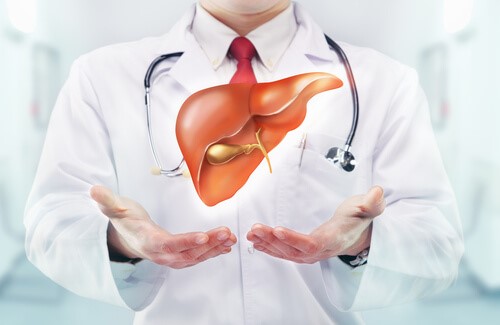The Role of Obesity in Fatty Liver Disease

Obesity has become a major public health concern in India. According to the National Library of Medicine, over 50 percent of adults in India suffer from Abdominal Obesity.
Obesity is a major risk factor for developing Nonalcoholic Fatty Liver Disease (FLD), which may cause severe liver damage if left untreated over time.
This article is a comprehensive guide on Fatty Liver Disease and its relation with obesity.
What is Obesity?
Obesity is a complex medical condition which involves abnormal or excessive body fat. Obesity is a risk factor for many diseases, such as Type 2 Diabetes, and can cause increased health problems.
The most common way to diagnose obesity is by calculating a person’s Body Mass Index (BMI). In Asians, a BMI of 27.5 or higher can indicate obesity.
Obesity can be caused by uncontrollable factors such as genetics, as well as lifestyle choices such as unhealthy diet and physical inactivity.
What is Fatty Liver Disease?
Fatty Liver Disease (FLD) is a medical condition involving excess fat in one’s liver. It is also known as hepatic steatosis.
Fatty Liver Disease does not always pose a health risk. However, excess fat buildup over time can cause various health issues and prevent healthy functioning of the liver.
Fat buildup in the liver can cause health problems when it exceeds five percent of the liver’s weight.
What are the types of Fatty Liver Disease?
There are two types of Fatty Liver Disease:
1. Metabolic Dysfunction-Associated Steatotic Liver Disease (MASLD): Formerly known as Nonalcoholic Fatty Liver Disease (NAFLD), it is the more common type of FLD. Health conditions such as obesity and hypertension can increase the risk of MASLD.
2. Alcohol-Related Fatty Liver Disease (ALD): ALD is caused by alcohol consumption and is less common than MASLD. People who consume alcohol regularly and in excessive amounts are at increased risk of developing ALD.
There are two forms of MASLD: Simple Fatty Liver, which involves having fat in the liver without liver inflammation or cell damage, and Metabolic dysfunction-associated steatohepatitis (MASH), which involves liver cell damage and inflammation.
What are the Causes of Fatty Liver Disease?
Fat can accumulate in the liver due to extra body weight, high blood pressure, high blood sugar, and high cholesterol.
The causes for Nonalcoholic Fatty Liver Disease are not entirely clear.
However, there are several known risk factors which can increase the chances of developing Fatty Liver Disease:
1. Obesity
2. Type 2 Diabetes
3. High Blood Pressure
4. High Blood Fat Levels
5. Sleep Apnea
6. Old Age
7. Chronic Kidney Disease
What are the Symptoms of Fatty Liver Disease?
Fatty Liver Disease usually does not cause symptoms. If symptoms are present, they include:
1. Abdominal pain
2. Extreme exhaustion or weakness
It is more likely for Fatty Liver Disease to manifest symptoms when it progresses to cirrhosis (severe scarring) of the liver. Cirrhosis symptoms include:
1. Nausea
2. Unexplained weight loss
3. Swelling of the abdomen, as well as legs, hands, or feet
4. Loss of Appetite
5. Yellowing of skin or whites of eyes
6. Bleeding in oesophagus, stomach or rectum
What is the role of Obesity in Fatty Liver Disease?
Obesity is directly linked with Fatty Liver Disease. It is a known risk factor for FLD.
A study published in ScienceDirect found that patients with obesity were at increased risk of developing Nonalcoholic Fatty Liver Disease as well as Nonalcoholic Steatohepatitis.
Fatty Liver Disease is not always a health risk by itself. However, it can still be dangerous as its lack of symptoms allows it to go undiagnosed and potentially cause serious liver damage (cirrhosis).
Catching and treating Fatty Liver Disease early can help prevent its progression into cirrhosis and the resulting health complications.
Thus, it is important for individuals with obesity to consult a doctor and get tested for Fatty Liver Disease as learning to manage and prevent obesity can reduce one’s chances of developing FLD.
How Can Obesity be Prevented?
Obesity can be caused by family genetics. However, there are several actions one can take to prevent or manage it in other cases, and prevent the role of obesity in Fatty Liver Disease:
1. Maintain a healthy diet and consume plenty of vegetables and fruits.
2. Avoid processed foods high in sugar, salt, and fat.
3. Reduce daily stress.
4. Incorporate regular physical activity into the daily schedule.
Catching Fatty Liver Disease early can prevent its progression into liver cirrhosis. Individuals who suffer from obesity are at a higher risk of developing FLD and are advised to book a liver function test at Dr Lal PathLabs for early diagnosis and treatment.
FAQs
1. Is Fatty Liver dangerous?
Early-stage Nonalcoholic Fatty Liver Dangerous is usually not dangerous. However, if untreated, it can lead to serious liver damage, including cirrhosis.
2. What is the life expectancy with Fatty Liver Disease?
Fatty Liver Disease without liver scarring does not affect life expectancy. However, cirrhosis can reduce life expectancy to ten to three years, depending on how late it is diagnosed.













